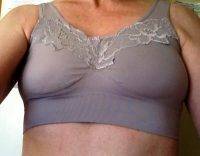Excess Skin In The Armpit Area After Breast Reduction
Excess skin after breast reduction can be contoured, but not usually covered by insurance
Contouring the area of excess skin in the armpit area after breast reduction is often necessary, and very possible and safe to do.
This most often involves some combination of liposuction and skin removal, and satisfaction is usually very high.
The insurance issue is more sticky. Most often it is not possible to justify the necessity for this to your insurer, as the excess tissue is not compromising your current or future health or limiting your function, it’s just making you look less attractive than you would like.
Given the nature of the issue, though, it shouldn’t be too expensive, and current financing options are excellent. (Armando Soto, MD, FACS, Orlando Plastic Surgeon)
It’s not unusual for women with breast enlargement to have a roll of skin and subcutaneous tissue that extends posteriorly from the breast. In many cases, this tissue extends all the way to the midline of the back.
This tissue often lies beneath the bra strap and can be very noticeable. Although every effort is made to address this issue during surgery, it’s not uncommon to have a residual roll of skin and fat in this area.
Efforts to address this problem at the time of surgery can involve extending the incision posteriorly to remove excess skin and fat. In other cases, there may be excess fat with good skin tone. In this situation, liposuction might be the best option.
Although secondary procedures designed to correct these types of problems have high success rates, they are very rarely covered by insurance carriers. They are typically viewed as cosmetic and therefore not medically necessary. For many patients, this excess tissue is not only unsightly, but also causes them difficulty wearing standard under garments.
Correction of this problem is associated with high satisfaction rates. If you have concerns about this type of problem, consultation with your plastic surgeon would be appropriate. (Richard J. Bruneteau, MD, Omaha Plastic Surgeon)
Underarms are not breasts
Insurance covers, if medically necessary, a breast reduction. It will not cover removal or treatment of excess skin under your arms or lateral to the breasts. That is not breast tissue. It can be treated, however, often with liposuction.
Excess Flab on Sides After Breast Reduction
This is a common problem among overweight women who have a breast reduction. The lateral tissue is fat not breast tissue and the insurance companies will not pay to remove it.
Some patients have paid a fee to the surgeon, anesthesiologist, and OR facility to take care of the lateral fat at the same time as a cosmetic procedure. (Paul Vitenas, Jr., MD, Houston Plastic Surgeon)
Flab and roll around bra strap following breast reduction
The problem is to determine if this is localized breast tissue, fat and/or skin. Depending on the evaluation further breast reduction, liposuction, or dermolipectomy (removing skin and fat) may be indicated. (Otto Joseph Placik, MD, Chicago Plastic Surgeon)
Unfortunately, flab is the normal after breast reduction
Women that have large natural breast unfortunately usually have excess fat under their armpit, or that hangs out in a roll over their bra strap on the side. Most surgeons also make a horizontal scar under the breast, which makes the fat just past the scar bulge out even worse, called a “dog ear” for those in the know.
For anyone undergoing breast reduction, first ask your plastic surgeon to liposuction at the time of the surgery.
You can also ask your plastic surgeon if you are a candidate for a “Vertical mammaplasty”, which has a more lollipop type scar and seems to pull that fat in toward the breast better.
If you have already had breast reduction and you have the roll, you can certainly see if your insurance company will cover the procedure, but it is far less likely they will cover it as a separate procedure. (Lisa Cassileth, MD, FACS, Beverly Hills Plastic Surgeon)
Oftentimes with breast reduction surgery we combine liposuction at the time of surgery to help with the lateral (sides) which are full. It is also possible to the liposuction as a secondary procedure at a later time.
Unfortunately, I doubt the insurance company will pay for the procedure now as a secondary case. The other option may be Smartlipo done in the office. It is all depends how much tissue needs to be removed. (David Shafer, MD, New York Plastic Surgeon)
Contouring the chest can enhance breast reduction
It is uncommon today that I perform breast reduction surgery without the use of liposuction. When using a vertical or a short scar technique the liposuction is very helpful to shape the periphery of the breast, contour the fold under the breast, and to reduce the fullness that extends off the breast and onto the chest under the arm.
The fold can be concealed to the side and not noticed. Also patients are not likely to understand that reduction of the breast will not correct the back roll unless it is specifically addressed.
The side and back roll can be corrected with liposuction if the skin excess is not too great.
If the skin is truly redundant it can be removed by extending the T scar common in breast reduction further out along the side. The scar may be a problem for some.
An upper body lift may help address fullness lateral to the breast
Laxity in the skin and fat lateral to the breast can bunch up above and below the side strap of a brassiere. Looseness in this skin also can join with fullness along the side of the rib cage and love handle area.
An upper body lift can remove this extra skin, but the design of the incisions is heavily dependent on the distribution of this extra skin. It is very important to have a direct conversation and hands on examination by a Board Certified Plastic Surgeon with extensive experience in body contouring to determine the best approach for you.
Even then, it would be rare for an insurance company to cover such a procedure. (David N. Hing, MD, Ann Arbor Plastic Surgeon)
The Batwings should be part of any Breast reduction
Many woman are faced with large breasts that extend around the chest wall onto the back. There can be excess fat, breast tissue and skin in these areas. Surgery can include liposuction (good if there is minimal excess skin) or surgical excision of the skin and fat/breast tissue.
Liposuction commonly needed with breast reduction
Liposuction of the outer chest wall is a common need for breast reduction patients. Although this area certainly contributes to the overall shape and look of the breasts, it is not actually breast tissue.
Therefore, this is considered cosmetic in nature most insurance companies usually will not pay for it. (Kevin Brenner, MD, FACS, Beverly Hills Plastic Surgeon)
Lipo can help a lot; extending the incision to remove skin may be needed
There is an extension of breast tissue in the axilla called the tail of spence. The breast is largely replaced by fat as one gets older, so does the fat in the tail of spence.
Insurance will not pay for the liposuction of this tail of spence. As part of the surgery, I will frequently do liposuction of this area, otherwise the patient complains that the breast is wide and flat.
This lipo of the axilla can easily be done through the outer incision, and you usually get 300 to 500 cc’s of fat from each side.
This helps form the breast and define the breast so that it is not so flat and wide.
Patients really appreciate this contouring. If there is also extra skin, that must be removed by extending the incision into the armpit.
Unfortunately, extending the incision makes it easier to see the scar in a bathing suite, but you have to do what is dictated by the diagnosis.
Thankfully this is not needed as much if you just do the lipo to the axillary tail of spence. (Dan Mills, MD, Orange County Plastic Surgeon)
Excess flab after breast reduction is a common complaint
Many women (particularly those who are overweight) have excess tissue that extends past the outside of the breasts under the arms as a fold of skin and fat. This typically lies under the bra strap.
Breast reduction is typically limited to the breast tissue itself and therefore does not involve removing the excess “flab” on the sides. However, this “flab” can become more noticeable after breast reduction and is a common complaint after surgery.
Improvement may occur with weight loss and/or time. Surgical correction may involve liposuction and/or excision of the “flab” which may involve additional scarring.
Surgical correction is not likely to be covered by insurance as it is basically a different issue from and unrelated to the enlarged breasts that were corrected by the breast reduction surgery. (Christopher W. Chase, MD, Chattanooga Plastic Surgeon)








